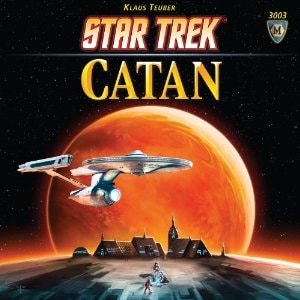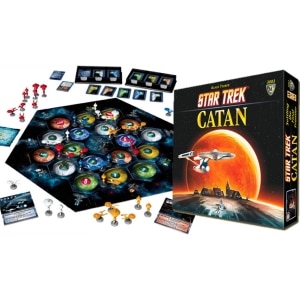Star Trek: Catan board game (board game review)
‘Settlers of Catan’ is a celebrated board game in which you gather resources, trade with your opponents and build roads and settlements in pursuit of total mercantile domination on a tiny island of improbable ecological diversity. It’s spawned multiple expansions, a cult following and innumerable ‘wood for sheep’ puns and is an enduring staple of geekmoots everywhere.
‘Star Trek’ is a celebrated TV series in which the crew of the USS Enterprise seek out new life and new civilisations (which often resemble historical Earth civilisations to an uncanny degree) in a desperate attempt to sate Captain Kirk’s irrepressible sex drive. It’s spawned multiple spin-offs, a cult following and innumerable appalling works of slashfic and is an enduring staple of geeky flame wars everywhere.
They are not the most obvious of bedfellows, though Kirk would probably give it a try.
Nonetheless, ‘Star Trek: Catan’ is a pretty decent game, primarily because it makes almost no attempt to improve upon the tried-and-tested game mechanics of core Settlers. Whereas before the players would plunder forests, fields and mountains for iron, wood and sheep, now they have a chance to pillage virgin (steady, Captain) planets for Tritanium, Dilithium, oxygen, water and food. Instead of building roads, settlements and cities, they construct starships, outposts and starbases. Where once a bandit used to raid their caravans, now they are menaced by a Klingon Bird-Of-Prey.
For those few readers unfamiliar with the game mechanics, they go like this. The board is made up of 19 planet hexes, distributed at random and assigned a number between one and twelve, excluding seven. There are five types of planet, each producing a different resource and an asteroid field in which the Klingon lurks.
The players place two outposts and two starships on the board, on the edges and corners between planet tiles, and then take turns to roll 2d6 (2 6 sided dice) to see which planets produce resources this turn. Whoever has an outpost or starbase neighbouring the lucky planet receives the relevant resource.
If a seven is rolled, the Klingon comes out of the asteroid field and is placed by the rolling player on a planet of their choice, where it blocks all resource production until the next seven comes up and it’s moved elsewhere.
Resources can be used to build more starships and outposts or convert an outpost into a starbase, which produces double the resource from neighbouring planets. You can only build outposts on locations reached by your starships and not on a corner next to another existing outpost, whether yours or another player’s.
Finally, you can also trade your resources in for a Development Card, which might protect you from the Klingon, speed your construction efforts or simply offer a victory point. Outposts are worth 1VP, starbases are worth 2 and the winner is the first to 10.
Core gameplay revolves around securing the necessary resources to build up your empire, primarily through trading with your opponents or with the bank, at a deeply unfavourable rate. Like most games of this type, there aren’t any rules governing trade between players, so the winner tends to be the canniest or most unscrupulous trader at the table.
This should all sound very familiar to anyone who’s played the original Settlers, because it’s ported directly from the earlier game. The only place in which ‘Star Trek: Catan’ differs is in the use of Support Cards: characters from the original ‘Star Trek’ series whose special abilities can aid their player. Each player can only hold one Support Card at a time and their abilities can only be used a maximum of twice before they must be traded in for a difference character.
All of the abilities are useful in different ways and at different points in the game, so the Support Cards add an extra layer of strategy on top of the basic trading game. Snag Scotty early and you can build starships much easier, boosting the number of prime outpost spots you’ll be able to reach later in the game. Chekov is essential if the Klingon’s crippling your resource-collection, banishing the Bird-Of-Prey back to the asteroid field, while Nurse Chapel allows those lagging behind in victory points to beg resource cards from leading opponents.
While the theme behind the Support Cards’ abilities is clear in some cases (Scotty’s engineering prowess, for example), others make less sense. Why does Uhura let you force others to trade with you? What’s the logic behind Spock’s ability and who the hell is Janice Rand? But this is just an aspect of the game’s biggest general flaw in that the ‘Star Trek’ license is erratically and sometimes thoughtlessly applied.
For example, it makes no sense to replace original Settlers’ roads with starships. Are traders walking between planets along the back of infinite Enterprises? Similarly, it’s impossible to justify the improved trading for building an outpost on the edge of the board. It made sense in the original game, because the board represented an island and a settlement on the edge was therefore a port. But here, where the board is a collection of planets (presumably representative of planetary systems, unless in-game astrophysics has made some pretty wild leaps sideways), why does access to a board edge grant a more efficient trading ratio? Are there resource-hungry aliens lurking in the void between galaxies or perhaps it’s good ol’ whimsical Q?
Ooops, wrong series. Forget I said anything.
Primarily, this is an aesthetic problem and doesn’t affect gameplay, but we’re talking about Trek fans – our pedantry and obsession with minutiae are legendary, so these internal inconsistencies are likely to niggle at the likely target audience. Yes, you can decide that the starships you build are representative of established trading routes rather than literal, individual vessels or handwave Mr Scott’s ability to build spacecraft from food and water, but the minimal effort put into tying the theme and game mechanics together smacks ever-so-slightly of Treksploitation.
That said, there’s no sign that the manufacturers skimped on production costs. The starships, outposts and starbases are detailed and well-made models and while the nacelles on the starships might seem doomed to breakage they’re less fragile than you’d expect. One of my playtesters was particularly delighted with the way outposts can be upgraded into starbases by slotting a ‘habitat ring’ onto the existing model, an admittedly nifty piece of design.
The game’s various cards are printed on sturdy stock, too, while the hexagonal planet tiles are precisely cut and so far have tessellated cleanly, marking a definite improvement on the original Settlers’ tiles, which often seemed to require…persuasion.
In conclusion, ‘Star Trek: Catan’ is more of a re-skin of the original Settlers than a new game in its own right; while the addition of the character-themed Support Cards does bring something new, over several games of playtesting their effect seemed fairly minor.
Nonetheless, it’s a handsome, physically well-made game and the tried-and-tested Settlers rules are as fun as ever. If you’re a ‘Star Trek’ fan and you don’t already have a copy of Settlers, this is definitely worth considering. If you already own the original, however, I’m not sure ‘Star Trek: Catan’s limited innovation is enough to justify the purchase. But I may be underestimating the attraction of the Kirk.
I wouldn’t be the first.
Martin Jenner
December 2012
(pub: Mayfair Games/Esdevium Games. B008MWWEJI Price: £44.99 although it can be bought at £33.76 (UK))
check out website: http://www.amazon.co.uk/Star-Trek-Catan-Board-Game/dp/B008MWWEJI/ref=sr_1_cc_1?s=aps&ie=UTF8&qid=1354790496&sr=1-1-catcorr and http://www.catan.com/


